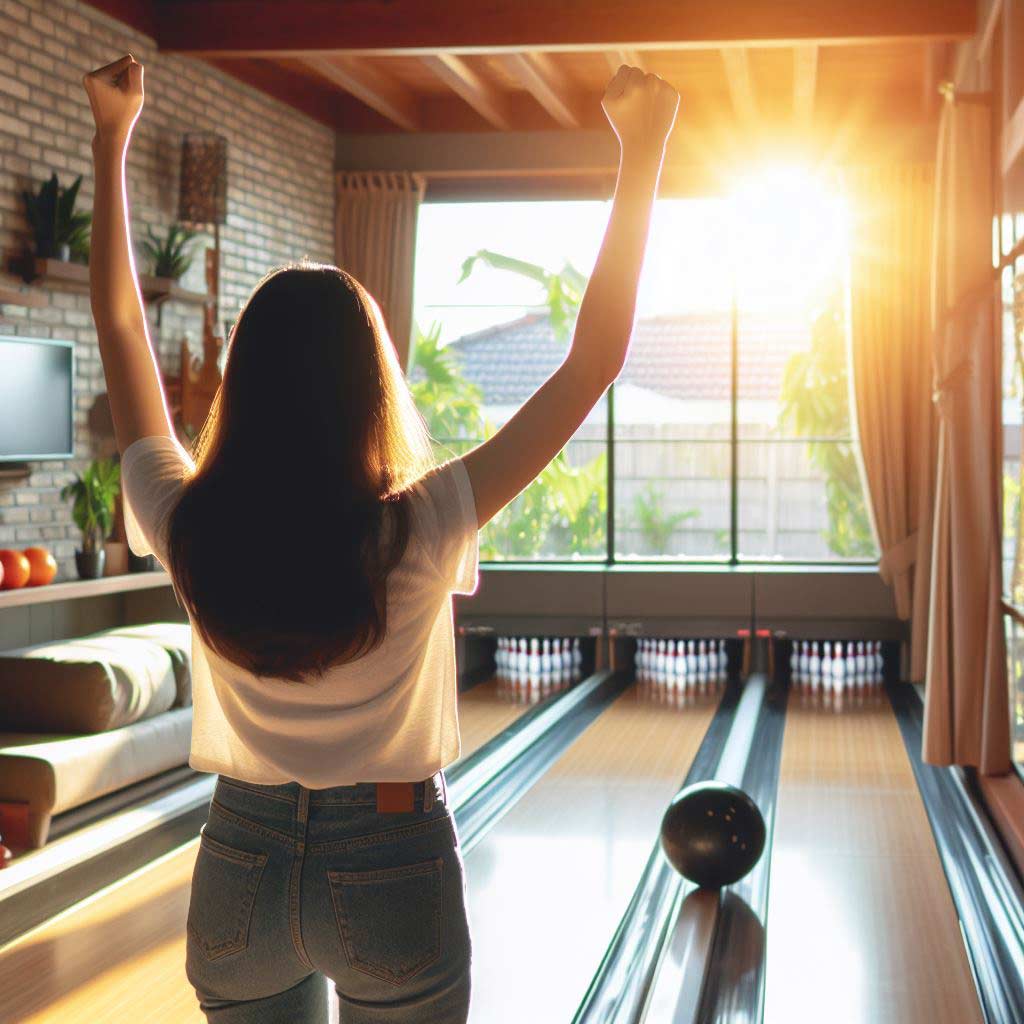Bowling is a classic American pastime that brings friends and families together for hours of fun competition. And there’s nothing better than being able to play a quick game without having to drive to the bowling alley. No wonder installing a bowling lane at home has become many homeowners’ dream project!
With the right amount of space and budget, you can create a miniature bowling alley right in your basement or backyard. A home bowling lane provides entertainment for all ages, rain or shine.
Kids can hone their bowling skills after school, and you can plan exciting themed parties with friends. But before getting swept up in the possibilities, it’s important to understand what goes into building a DIY home bowling lane.
This comprehensive guide covers everything you need to know, from costs and space requirements to the construction process and equipment needed. With thorough planning and preparation, you’ll be rolling strikes in no time!
Costs of Installing a Home Bowling Lane
Constructing a Brunswick regulation-size home bowling lane approximately 60 feet long and 42 inches wide starts at around $10,000. But the total cost can range between $25,000 to $40,000 once you factor in specialized equipment like pins, ball returns, and scoring systems.
Here’s a breakdown of typical home bowling alley installation costs:
Lane Construction
- Synthetic bowling lane wood planks – $3,000 to $7,000
- Underlayment for leveling and support – $1,500 to $2,000
- Professional installation – $2,000 to $5,000
- Lane oil/conditioner and application machine – $1,500 to $2,500
Pinsetter and Pins
- Automatic pinsetter machine – $7,000 to $12,000
- 10 bowling pins – $150 to $300
- Ball lift and ball return – $2,000 to $4,000
Additional Equipment
- Scoring system and monitors – $2,000 to $3,000
- Balls and bag – $150 to $600
- Lane bumpers – $800 to $1,500
- Seating/tables – $500 to $2,000
There are also ongoing maintenance costs for conditioning oil, pin repairs, mechanical fixes, etc. which can run $700 to $1,500 annually.
However, you can reduce these home bowling alley construction costs through DIY installation, buying used equipment, minimal scoring systems, and limiting lane length. A more barebones 20 to 30-foot lane with used equipment could cost between $10,000 to $15,000.
How Much Space is Needed for a Home Bowling Lane?
While professional bowling lanes are 60 feet from the foul line to the pins, home bowling lanes can be constructed at shorter lengths while keeping regulation 42-inch width. Here are some general space requirements:
- 20-foot length – Minimum for short recreational play. Needs about 22 feet including the pin deck. Fits in some basements.
- 30-foot length – Comfortable for families and casual play. Needs about 32 feet total.
- 40-foot length – Allows for more serious play. Requires around 42 feet of total space.
- 60-foot regulation length – Ideal for competitive practice. Needs about 62 feet total.
For the bowler’s approach area, allow for at least 15 feet of length from the foul line backward before any walls. This permits a running start. Account for seating space on the sides or behind the approach.
For height, plan for at least 10 feet of clearance above the lane if in a converted basement. On a ground floor, ceiling height is not an issue.
Consider the space needed for additional components like ball returns which run along the sides or back of the lane. Talk to your installation contractor about the layout. Also, think about easy access for maintenance.
How to Build and Install a Home Bowling Lane
Constructing the lane itself requires expert craftsmanship best left to professionals. But if you want to DIY part of the process, here are the general steps involved:
Securing the Underlayment
The lane sits on top of an underlayment made from joists or crossbeams to create a strong and perfectly level foundation. These are secured to the concrete floor using anchors or adhesive.
Installing Synthetic Lane Materials
The bowling lane is made of narrow maple wood or synthetic material on top of the underlayment. Adhesives and screws hold the planks in place flush against one another.
Sanding and Finishing the Lane
The wood or synthetic surface needs proper sanding to create a smooth ball roll. A glossy oil-resistant finish is applied for protection and aesthetics.
Adding Lane Components
The specialized gutter channels, foul indicators, scoring sensors, and pin spot markings get installed on the lane surface at exact measurements.
Conducting Inspections and Safety Checks
With wiring and heavy machinery involved, it’s important your electrical system can handle the required power. Have building inspectors examine the installation for safety.
Hiring professional bowling lane builders is recommended, as they have experience with zoning laws, ventilation needs, and equipment integration. But you can save on labor by assisting with simple preparations, demolition, or cleanup.
Purchasing Additional Bowling Equipment
Beyond just constructing the lane itself, you’ll need other vital equipment for your home bowling alley.
Pins and Pin Setting Machines
Standard 10 bowling pins made of hard rock maple wood need to be professionally fitted with a pin deck machine. Automatic resetters return pins after they’re knocked over.
Balls and Ball Returns
Have at least 4 to 6 house bowling balls of varying weights (8 to 16 lbs). A manual or automatic ball return lifts and drops balls back to players.
Scoring Systems
From old-school paper score sheets to modern electronic scoring consoles, you have options for tracking games. Choose furniture and displays that match your bowling room decor.
Lane Bumpers
Bumpers that extend from gutters are great for kids and amateurs. Higher-end lanes even have programmable bumper settings.
Seating and Decorative Elements
Comfortable benches or chairs adjacent to lanes allow players to relax between turns. Add your own unique flair with furniture, neon signs, or locker decor.
Work with your contractor to purchase equipment that fits your budget. You can often find quality used pins, ball returns and scoring systems to save costs.
Maintaining Your Home Bowling Lane
Like any high-traffic sports facility, home bowling lanes require regular upkeep for peak performance and safety:
- Clean oil residue from lanes monthly using an approved cleaner. Re-oil lanes bimonthly according to product instructions.
- Inspect pins for cracks or damage after heavy use. Rotate and replace pins annually as needed.
- Check ball lift wheels, pinsetters, and other mechanical systems for changes in functioning. Replace worn parts.
- Touch up wood lane finish once a year using compatible polyurethane sealant. Lightly sand and re-coat as needed.
- Inspect wiring connections to scoring equipment annually. System upgrades may be needed over time.
- Address any uneven boards, splintering or cracks in the lane surface right away before they expand.
Following the manufacturer’s maintenance directions can maximize safety and extend the lifespan of your bowling lane.
The Thrills of Home Bowling Without the Commute
What better way to bring family and friends together for hours of entertainment than with the convenience of your at-home bowling alley?
With the right preparation and forethought, you can create classic bowling excitement minus the noisy crowds. Kids gain a fun place to practice skills and invite peers. Or surprise your spouse with an anniversary garage renovation into a couples’ retreat.
Even if you have the minimum length and basic equipment, the nostalgia and enjoyment outweigh the investment. For serious bowlers, nothing beats being able to practice shots and improve scoring whenever you want. And opening up your personal bowling lane for parties makes you the most popular host on the block!
The construction process requires careful planning and likely hiring specialized professionals. Be sure to get quotes from multiple lane installation contractors. While the upfront cost is significant, the years of personalized use make it worthwhile. Talk to your bank about financing options as well.
Make your dream of bowling in your pajamas at 2 am a reality! With this guide’s advice for budgeting, space planning, construction, equipment selection, and maintenance, you’ll be well on your way to strikes, spares, and smiles with your own home bowling lane. Just be prepared for some “gutter” balls as you learn the ropes.
Frequently Asked Questions
Can you make bowling alley at home?
Yes, with enough space and budget, you can install a home bowling lane or alley in your basement, backyard, garage, or dedicated room. Typical costs range from $10,000 for a basic short lane to over $40,000 for a regulation lane with full equipment.
Does a bowling alley add value to your home?
Adding a bowling lane can increase a home’s value, especially for luxury properties. However, it’s a very customized addition so it may attract a narrower market. The increase in home value is typically far less than the construction cost.
What is a bowling lane called?
The bowling lane itself is often called the alley. Professionally built lanes have synthetic materials like wood-laminate overlaying crossbeam underlayment. The lane length from the foul line to the pins is 60 feet for regulation tournaments.
How much space do you need for a bowling lane?
For a full 60-foot regulation lane, you need about 70 feet of length with an approach area. But home lanes can be as short as 20 feet long if space is limited. The width is always 42 inches. The ceiling height should be at least 10 feet.
How do you build a backyard bowling alley?
Build a level, rectangular foundation of compacted gravel. Install underground wiring and plumbing if desired. Construct a wood or concrete base topped with synthetic lane materials secured with adhesive and screws. Add necessary equipment like pins, balls, and scoring. Enclose and finish the structure.
What do you need to make a bowling alley?
Essential components are the lane itself, bowling pins and pinsetting machine, balls with ball return, scoring system, and seating. Optional additions include bumpers, projector screens, and food/drink areas.
Why are bowling alleys in basements?
The large amount of space required for a regulation 60-foot lane makes basement installation ideal. The underground location also provides temperature control, sound isolation, and ease of installing mechanical equipment.
Why is going bowling so expensive?
Bowling alley overhead costs are high for specialized equipment maintenance, lane conditioning, staffing, insurance, utilities, and property taxes. These costs are divided among customers resulting in higher pricing for open bowling, shoe rentals, etc.
Can you bring your own bowling ball to a bowling alley?
Most bowling alleys allow you to bring your own clean ball and shoes. House balls are also provided. Custom balls must meet weight and size regulations. The alley may inspect and clean external balls before use.





